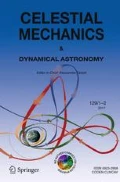Abstract
The aim of this paper is the development of a model to propagate space debris in the geostationary ring considering the \(J_2\) effect due to the Earth oblateness, the Sun and Moon perturbations, and the solar radiation pressure. We justify the importance of considering the \(J_2\) effect when propagating space debris independently of the ratio A / m for short and long-term propagation. We study the role of the Sun and the Moon in the period and amplitude of the inclination for different values of A / m. Thanks to the Hamiltonian formulation of the problem and the use of Poincaré’s variables it is possible to express the evolution of the space debris through a simplified dynamical system. We test and validate our obtained analytical solutions with the numerical ones, computed with a powerful integrator named NIMASTEP. We analyse the improvements obtained when we include the \(J_2\) effect and the third body perturbations by a rigorous comparison with a previous model, which only considers the solar radiation pressure. Finally, we study the effect of the area-to-mass ratio on short and long-term propagation.












Similar content being viewed by others
References
Abad, A.: Astrodinámica. Bubok Publishing S.L. (2012)
Avendaño, M.E., Davis, J.J., Mortari, D.: The 2-D lattice theory of flower constellations. Celest. Mech. Dyn. Astr. 116(4), 325–337 (2013)
Belyanin, S., Gurfil, P.: Semianalytical study of geosynchronous orbits about a precessing oblate Earth under lunisolar gravitation and tesseral resonance. J. Astronaut. Sci. 57(3), 517–543 (2010)
Bombardelli, C.: Analytical formulation of impulsive collision avoidance dynamics. Celest. Mech. Dyn. Astr. 118(2), 99–114 (2014)
Casanova, D., Tardioli, C., Lemaître, A.: Space debris collision avoidance using a three-filter sequence. MNRAS 442(4), 3235–3242 (2014)
Casanova, D., Avendaño, M.E., Tresaco, E.: Lattice-preserving flower constellations under \(J_2\) perturbations. Celest. Mech. Dyn. Astr. 121(1), 83–100 (2015a)
Casanova, D., Lemaître, A., Petit, A.: AAS 15–236 Analysis of the evolution of space debris through a synthetic population. In: 25th AAS/AIAA Space Flight Mechanics Meeting, Williamsburg, VA (2015b)
Delsate, N., Compere, A.: NIMASTEP: a software to modelize, study, and analyse the dynamics of various small objects orbiting specific bodies. Astron. Astrophys. 540, A120 (2012)
Hubaux, C., Lemaître, A.: The impact of Earth’s shadow on the long-term evolution of space debris. Celest. Mech. Dyn. Astr. 116(1), 79–95 (2013)
Hubaux, C., Lemaître, A., Delsate, N., Carletti, T.: Influence of Earth’s shadowing effects on space debris stability. Adv. Space. Res. 51(1), 25–38 (2012)
Klinkrad, H.: Space Debris: Models and Risk Analysis. Springer, Berlin (2006)
Lemaître, A., Delsate, N., Valk, S.: A web of secondary resonances for large \(A/m\) geostationary debris. Celest. Mech. Dyn. Astr. 104(4), 383–402 (2009)
Rossi, A., Valsecchi, G.B.: Collision risk against space debris in Earth orbits. Celest. Mech. Dyn. Astr. 95(1–4), 345–356 (2006)
Valk, S., Lemaître, A.: Semi-analytical investigations of high area-to-mass ratio geosynchronous space debris including Earth’s shadowing effects. Adv. Space. Res. 42, 1429–1443 (2009)
Valk, S., Lemaître, A., Anselmo, L.: Analytical and semi-analytical investigations of geosynchronous space debris with high area-to-mass ratios. Adv. Space. Res. 41, 1077–1090 (2008)
Valk, S., Lemaître, A., Deleflie, F.: Semi-analytical theory of mean orbital motion for geosynchronous space debris under gravitational influence. Adv. Space. Res. 43, 1070–1082 (2009)
Vallado, D.: Fundamentals of Astrodynamics and Applications, 2nd edn. Space Technology Library (2001)
Acknowledgments
The work of D. Casanova was supported by the research project with reference CUD1315 in the organism Centro Universitario de la Defensa de Zaragoza, and by the Spanish Ministry of Economy and Competitiveness (Project No. ESP201344217-R). The work of A. Petit was supported by a FRIA Ph.D. grant in the Department of Mathematics at the University of Namur.
Author information
Authors and Affiliations
Corresponding author
Rights and permissions
About this article
Cite this article
Casanova, D., Petit, A. & Lemaître, A. Long-term evolution of space debris under the \(J_2\) effect, the solar radiation pressure and the solar and lunar perturbations. Celest Mech Dyn Astr 123, 223–238 (2015). https://doi.org/10.1007/s10569-015-9644-1
Received:
Revised:
Accepted:
Published:
Issue Date:
DOI: https://doi.org/10.1007/s10569-015-9644-1




